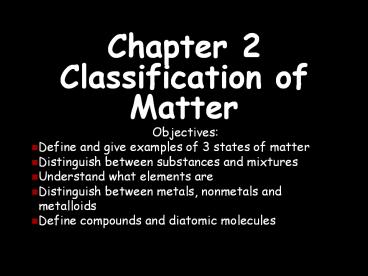Chapter 2 Classification of Matter - PowerPoint PPT Presentation
1 / 27
Title:
Chapter 2 Classification of Matter
Description:
Chapter 2 Classification of Matter Objectives: Define and give examples of 3 states of matter Distinguish between substances and mixtures Understand what elements are – PowerPoint PPT presentation
Number of Views:247
Avg rating:3.0/5.0
Title: Chapter 2 Classification of Matter
1
Chapter 2Classification of Matter
- Objectives
- Define and give examples of 3 states of matter
- Distinguish between substances and mixtures
- Understand what elements are
- Distinguish between metals, nonmetals and
- metalloids
- Define compounds and diatomic molecules
2
What is Matter?
- Anything that has mass and occupies space
(volume) - Composed of atoms
- Exists in three states on earth
- Solid
- Liquid
- Gas
- Exists in fourth state in space
- Plasma (An electrically neutral,
- highly ionized gas state)
3
Solids
- Definite shape and volume
- Particles tightly packed in a lattice pattern
- Crystalline salt, sugar, quartz
- Amorphous solids no regular, geometric pattern
eg. Glass, plastic, gel
4
Liquids
- Definite volume
- Not a definite shape (Takes shape of container)
- Particles have more energy
- Particles can move freely
5
Gases
- Indefinite volume
- No definite shape
- Particles have high energy level
- Particles move independently of one another
6
(No Transcript)
7
Classfication Flowchart
MATTER
yes
no
Can it be physically separated?
Compound
Heterogeneous Mixture (mechanical)
Homogenous Mixture (solutions)
Element
8
Substances and Mixtures
- Pure Substance a particular kind of matter with
a definite, fixed composition - Elements (copper, gold, oxygen)
- Compounds (sugar, salt, water)
- Mixture a blend of two or more pure substances
- NOT chemically combined
9
Types of Mixtures
- Heterogeneous mixtures
- Visibly different parts
- Eg. Chocolate chip cookies granite
- Two or more phases (usually)
- Homogeneous mixtures
- Different parts not visible (uniform throughout)
- One phase
- Eg. Sea water, air
10
Homogeneous Mixtures
- Also known as solutions
- very small particles (0.2 2.0 nm)
- no Tyndall effect (particles dont scatter light)
- particles dont settle
- Eg rubbing alcohol, air,
- brass alloy
11
Colloids
- Homogeneous or heterogenous? Difficult to
say - medium-sized particles
- (2.0 1000 nm)
- Tyndall effect
- particles dont settle
- Eg milk
12
Suspensions
- large particles (gt1000 nm)
- Tyndall effect
- particles settle
- Eg fresh-squeezed lemonade
13
Heterogeneous Mixtures
- Mechanical
- Several components mixed and visible
- Eg Raisin Bran
14
Pure Substances
- Elements
- A substance that cannot be separated into simpler
substances - Compound
- Two or more elements combined through a chemical
reaction - Different properties than elements which compose
it
15
Elements
- Classificiation
- Metal
- Nonmetal
- Metalloid
16
Elements
- Metals
- Usually solid at room temp
- Good conductors of heat and electricity
- High luster (shiny)
- Ductile easily pulled into wires
- Malleable easily beaten into thin sheets
- High melting point high density
- Usually dont combine with each other
- Readily combine with nonmetals
17
Elements
- Nonmetals
- Solids (C, P, S, Se, I2) Liquid (Br2) Gases
(all others) - Poor conductors of heat and electricity no
luster - Low melting point low density
- Will combine with each other (CO2)
- Will combine with metals or metalloids
- Some found uncombined in nature (noble gases)
18
Elements
- Metalloids
- Have properties of both metals and nonmetals
- Some used for semiconductors in electronics
- Eg Silicon, Germanium
19
Compounds
- Two or more elements chemically combined
- New properties
- Definite proportions
- Can be chemically separated
- Molecular (covalent) or Ionic
20
Compounds
- Molecular
- Held together with covalent bonds
- Molecule smallest uncharged individual unit of
a compound - Eg. Water, carbon dioxide
21
Compounds
- Ionic
- Ion positively or negatively charged atom or
group of atoms - Cation positive
- Anion negative
- Held together by ionic bond attraction between
positive and negative charges
22
Diatomic Molecules
- Always exist as 2 atoms
- 7 naturally occurring
- Hydrogen, oxygen, fluorine,
- bromine, iodine, nitrogen,
- chlorine
- H2, O2, F2, Br2, I2, N2, Cl2
- Memory tool HOFBrINCl pronounced
Hoffbrinkle
23
Chemical Formulas
- Subscript indicates of atoms present
- H2O has 2 Hydrogen atoms and 1 Oxygen atom
- H2SO4 has
- NaOH has
- C6H12O6 has
2 hydrogen atoms, 1 sulfur atom, 4 oxygen atoms
1 sodium atom, 1 oxygen atom, 1 hydrogen atom
6 carbon atoms, 12 hydrogen atoms, and
6 oxygen atoms
24
Separating Mixtures
- Do NOT cause chemical changes
- Heterogeneous Mixtures
- Filtration
25
Separating Mixtures
- Homogeneous Mixtures
- Distillation
26
Separating Mixtures
- Homogeneous Mixtures
- Chromatography
27
Separating Mixtures
- Homogeneous Mixtures
- Crystallization































